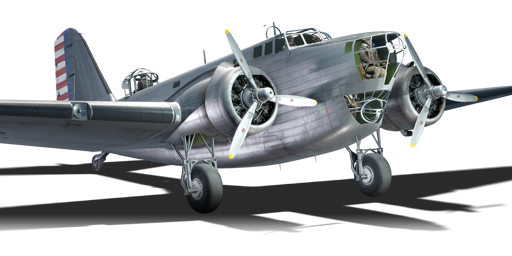



The B-18 was a medium bomber developed by Douglas to replace the Martin B-10 Bomber. It was much heavier and was based on the DC-2 passenger airliner. This large size, paired with mediocre engines, meant that by 1940 the aircraft was considered underpowered and undergunned, with mediocre defensive armament for the time. Shortly after its introduction, the B-18As became the backbone of the USAAC's bomber squadrons. Unfortunately, not long after the bombers arrived at their units, glaring deficiencies stood out, namely with cruise speed of the aircraft, its defensive armament and positions, its armour protection, and its overall payload size. This meant that most B-18s were deployed overseas during WWII. In Pearl Harbour, many were destroyed on the ground, without a chance to fight back against the Japanese bombers.
It was introduced in Update 1.59 "Flaming Arrows". This is the first multi-engine land-based bomber available in the American Bomber tech tree. With a maximum bomb load of 2,000 lbs, it is a decent medium bomber, although its gunners' fields of fire are somewhat poor, the only viable one being the dorsal turret gunner which suffers from the large blind spot the rudder creates directly behind the aircraft. It is recommended to level bomb at high altitude, as its poor manoeuvrability means you will have a hard time bombing moving ground targets at low altitude without a relatively straight bombing run.
flaps
flaps
flaps
brake
| Belt | Belt filling | Armor penetration (mm) at a distance: | |||||
|---|---|---|---|---|---|---|---|
| 10 m | 100 m | 500 m | 1000 m | 1500 m | 2000 m | ||
| T/Ball/Ball/AP/I | 13 | 12 | 7 | 3 | 2 | 0 | |
| T/AP/AP/AP/I | 13 | 12 | 7 | 3 | 2 | 0 | |












Flight performance | |
|---|---|
Survivability |
|---|
Weaponry | |
|---|---|